Are phone cases sustainable? Can compostable cases be durable? In this post, we’ll review the top seven eco friendly and sustainable phone case brands.
For each brand, we evaluated its performance as well as its impact on people and the planet.
Want more info on our assessment process? Read our section “What Makes an Eco Friendly or Sustainable Phone Case?”
Our goal in this post, is to ensure your purchases benefit people and the planet. Specifically, I'm wanting you to feel better about the next case you snap on that new phone.
Before I dive deep into each brand individually, we’ll cover a quick list of the best sustainable phone case brands. See the full reviews below.
Quick List — The Most Sustainable Phone Cases
Take a look at these seven sustainable phone case brands.
Pela (⭐️ 3.8) — 100% Compostable Phone Case
A Good Company (⭐️ 4.5) — Best Sustainable Phone Case for iPhone 13 and Samsung S22
15:21 (⭐️ 2.7) — Minimalist Phone Case
CASETiFY (⭐️ 3.1) — Sustainable Phone Case with Fun Designs
Go Nimble (⭐️ 3) — Best Recycled Phone Case
Wave (⭐️3) — Most Affordable Phone Case
Carved (⭐️3.5) Phone Case Made Sustainably in the USA
Pela
100% Compostable Phone Case
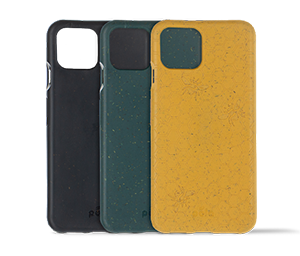
Price: $53-69
Made In: China and Canada
Overall score: 3.8/5
Performance: 5/5
People: 2.5/5
Planet: 4/5
Phone Sizes: iPhone (6-13), Samsung (S9-S22), Google Pixel (5-6)
Pros & Cons
👍 Compostable
👍 Plenty of colors and styles to choose from
👍 Plastic-free, recyclable packaging
👍 Screen protection guarantee (with liquid screen protector purchase)
👎 Higher price point
👎 Limited transparency with labor practices
Pela phone cases are made of Flaxstic®, a substance made with compostable bioplastic elastomer and flax straw materials. Made to last, the sustainable phone case is durable but not bulky. Plus there are plenty of designs and styles to choose from.
In our experience, we’ve found the Pela Cases to be protective (no broken/cracked screens to report), comfortable to handle, and pleasantly simple in style.
Pela is pretty transparent about production, including an overview on its About page that walks you through the process. One thing to note: they manufacture in China, but they’re not explicitly clear about the working conditions. Customers have reported confusion and surprise to find out the cases are made in China, when they believed them to be Canadian-made.
They have historically made contributions to 1% of the Planet and other organizations (like Save the Waves and Surfrider Foundation).
Looking for an additional sustainable screen protector? Pela offers one. The best part: if your screen cracks while wearing a case and the screen protector, they’ll cover the cost of your repairs up to $200.
When you’re ready to upgrade your phone, you can either give your compost pile something to munch on, send it to a compost facility, or return it through the Pela 360 program.
Video Review:
Pela Phone Case Review – Watch on YouTube
Where to Buy
→ $53-60﹘pelacase.com or EarthHero.com
→ Read Our Full Review: Pela Phone Case Review
A Good Company
Best Sustainable Phone Case for iPhone 13 and Samsung S22

Price: $29-$35
Made In: Sweden
Overall score: 4.5/5
Performance: 5/5
People: 4/5
Planet: 4.5/5
Phone Sizes: iPhone (12-13), Samsung (S22)
Pros & Cons
👍 Compostable
👍 Plenty of styles to choose from
👍 Textured for improved grip
👎 Not many android options
When it comes to ethical phone cases, A Good Company provides the whole package. The phone cases are made with linseed and are compostable, minimizing your carbon footprint and closing the production loop. Plus, they’re textured for an improved grip to keep your phone safer.
The linseed comes from an ecologically certified farm in Stockholm. From there, the materials travel to a family-owned factory to make linseed pellets. Then, they mold the cases at a second factory (which runs on solar power in the summer). The final stop is a print shop that uses organic plants. Compared to other phone case brands, A Good Company is extremely transparent about its production and supply chain.
Who said paintings are only for walls? If you like the oil on canvas vibe, their artist collections have plenty of fun options. Or, if you prefer a conversation starter, try this one of monkeys stealing a banana.
Aside from showing some personality, your purchase also supports global sustainability initiatives. For every phone case purchased, 4% goes to A Good Foundation. They also use Cradle to Cradle certified Stone Paper packaging, as opposed to plastic.
Time to trade in your old case? Their circularity program A Good Loop allows you to trade in your case for a discount on the next.
Where to Buy
→ $53-60﹘Agood.com
15:21
Minimalist Phone Case
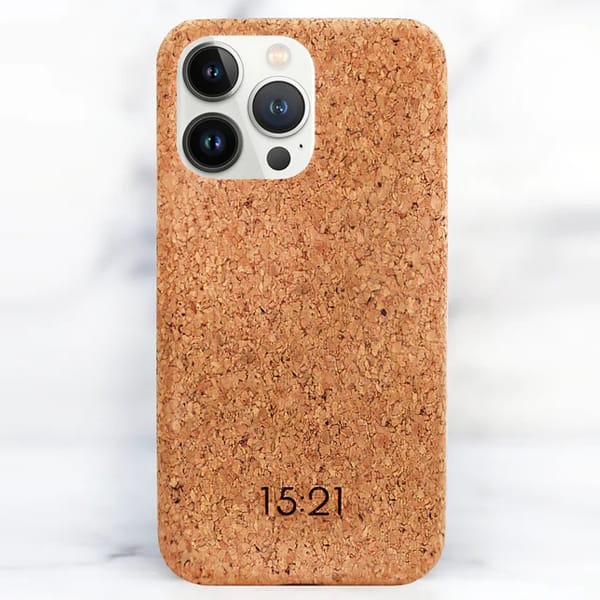
Price: $43
Made In: N/A
Overall score: 2.7/5
Performance: 3/5
People: 2/5
Planet: 3/5
Phone Sizes: iPhone (6-11; SE), Samsung (8-10); Huawei P20
Pros & Cons
👍 Made with sustainable cork
👍 4-year warranty
👍 Slim profile
👎Not available for Google Phones
👎 Not compostable
After missing the train to work, the founder of 15:21 realized he wanted to make a change. He hoped to find a way to protect the planet, not exploit it. That’s where the concept for 15:21 was born.
15:21 phone cases are made from Portuguese cork trees, without the use of pesticides or irrigation. They also don’t have to cut down the trees for production.
Wineries are using more plastic corks or aluminum screw tops for their bottles, so demand for cork has gone down. This decrease in demand has led to deforestation of cork oak trees, so by creating new uses for cork, 15:21 has supported the survival of the cork forests.
The 15:21 phone cases are slim and the cork makes for an interesting and enjoyable feel. While using the case we experienced no cracks or broken screens, it felt like there was potential given that the case doesn’t have a lip to it that extends beyond the screen itself.
From our research, it’s not clear how 15:21’s supply chain works or where factories are located. However, by purchasing a cork phone case, you’re potentially helping to protect cork oaks from being cut down.
As of right now, the company doesn’t have a return and recycle program. Natural cork is compostable, but the core of 15:21 cases is made of composite recycled glass, so you can’t toss this case in your soil and expect it to compost. Processed cork often ends up in the landfill without a second life or use. However, cork products only take 3-10 years to biodegrade, while plastic decomposition takes anywhere from 20-1,000+ years.
Where to Buy
→ $43﹘1521store.com or $46 at howcork.com
CASETiFY
Sustainable Phone Case with Fun Designs
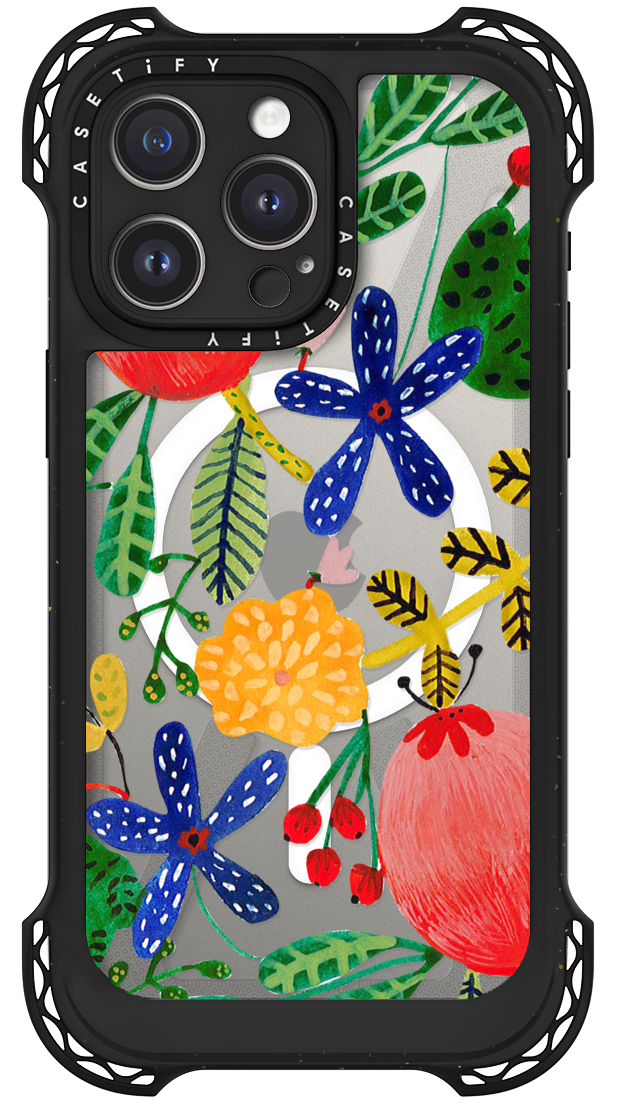
Price: $55 – $65
Made In: Hong Kong, Los Angeles
Overall score: 3.1/5
Performance: 4/5
People: 2/5
Planet: 3.5/5
Phone Sizes: iPhone (11-SE), Samsung Galaxy (S21-S22; Z), Google (Pixel 6)
Pros & Cons
👍 Customizable cases
👍 Compostable options
👍 Recycling program for any brand
👎 Not all cases are compostable
👎 Limited transparency with supply chain and labor practices
Founded with the intention to turn Instagram photos into phone cases, CASETiFY has evolved in the last seven years. Now, they provide a range of bright and playful colors and designs for iPhone, Samsung, and Google phones. From funky frosted swirls to checkered cowgirl boots, their designs are bold and memorable. They also still offer the option to customize your case, whether you want to add custom text or a favorite print.
Their Crush Cases use Re/CASETiFY technology, giving a second life to old phone cases. They also have plant-based, compostable phones, which customers can either send to a facility or return for a store credit. Even better: you can send in phone cases from any brand.
Without a list of suppliers or factories, it’s hard to say where CASETiFY lands in terms of labor practices. Safe to say we will keep you posted as we gather more information.
Through your purchase, you can support artists or causes, depending on the collection. At CASETiFY, every compostable case also means one tree planted through The Canopy Project.
Where to Buy
→ $55-65﹘casetify.com
Go Nimble
Best Recycled Phone Case
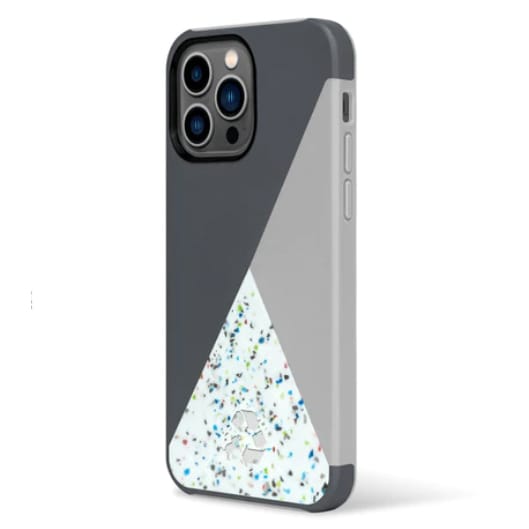
Price: $25 – $27
Made In: China
Overall score: 3/5
Performance: 3/5
People: 3/5
Planet: 3/5
Phone Sizes: iPhone (11-13)
Pros & Cons
👍 Made from recycled plastic
👍 2-year warranty
👎 Limited design options
👎 Only available for iPhones
DVDs and CDs have been given a second life through Go Nimble. The now-obsolete electronics are made from polycarbonate, a substance that’s estimated to take one million years to decompose. Recycled polycarbonate is used to make Go Nimble phone cases, though it’s unclear what percentage of the phone is recycled or if there are any added plastics.
If you prefer to show off the color of your iPhone, these cases have some clear options. They also offer a few designs with pastel colors and a marbled accent.
With a list of suppliers, locations, and number of employees, Go Nimble practices a level of transparency about its supply chain. When it comes to labor practices, suppliers are asked to self-monitor and share information with the company.
For shipping, the company uses recyclable packaging made from recycled paper. Every purchase comes with a free shipping label, so you can return for responsible recycling and get 15% off your next purchase.
Along with giving CDs a new life, your purchase helps protect elephant lives. A percentage of sales goes to Sheldrick Wildlife Trust, an elephant rescue organization.
Where to Buy
→ $55-65﹘gonimble.com, $25 at verizon.com, or $39 at target.com
Wave
Most Affordable Phone Case
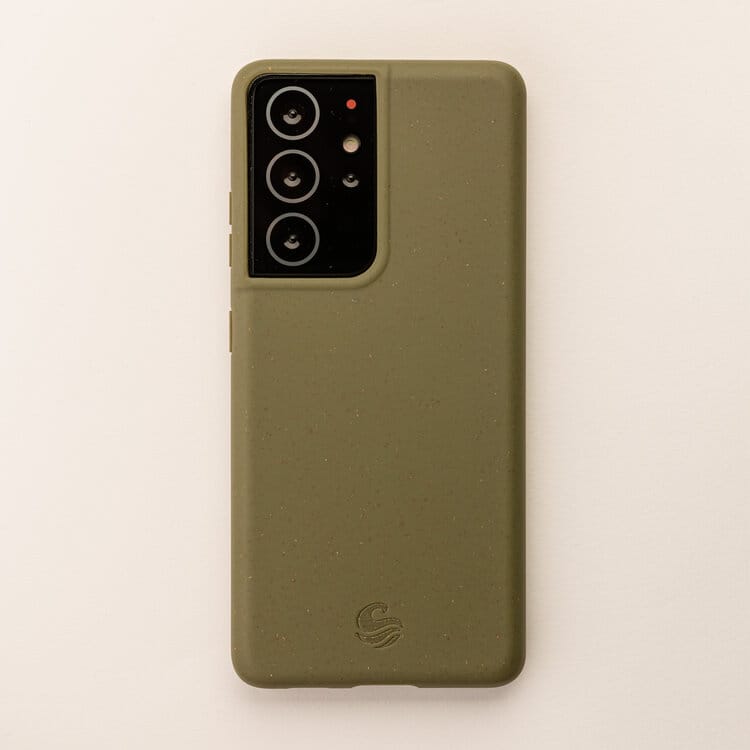
Price: $35 – $179
Made In: N/A
Overall score: 3
Performance: 3.5/5
People: 2/5
Planet: 3.5/5
Phone Sizes: iPhone (6-8; 11-13), Samsung Galaxy (A12-A72; S20-S22)
Pros & Cons
👍 Great for Plastic-free; made from wheat straw
👍 Budget-friendly
👍 Discount for returning old case
👎 Slightly thicker compared to others
👎 Can’t compost at home
👎 Only available for iPhone and Samsung Galaxy
Made from wheat straw, Wave cases are plastic-free and compostable in an industrial facility. With everything from bright yellow to subdued gray, Wave is sure to have the color for you. They also offer smooth and etched cases, so you can pick depending on your preferred look and feel.
Want to represent your love for protecting sea turtles? There’s an etched case for that. Designs include daisies, hearts, clouds, mushrooms, and more. After about two years of consistent use, the color starts to fade a bit. Some users also report the build to be a little too thick, but if you drop your phone more than average, the extra protection is a good option.
Wave works with Climate Partner to calculate their carbon emissions. Using their calculations, they offset CO2 by supporting Plastic Bank and contributing to wind farms in the Philippines and Aruba. They also use 100% plastic-free mailers made with recycled cardboard.
When it’s time to move onto a new phone, you have the option to either send it to a composting facility or return it to Wave. They’ll send you a 20% discount on your next case.
As members of the Surfers Against Sewage 250 Club, they donate £250 a year to protect the ocean. However, as far as transparency goes, we couldn’t gather much information on the company’s supply chain or labor practices.
Where to Buy
→ $18﹘wavecase.co.uk
Carved
Made sustainably in the USA
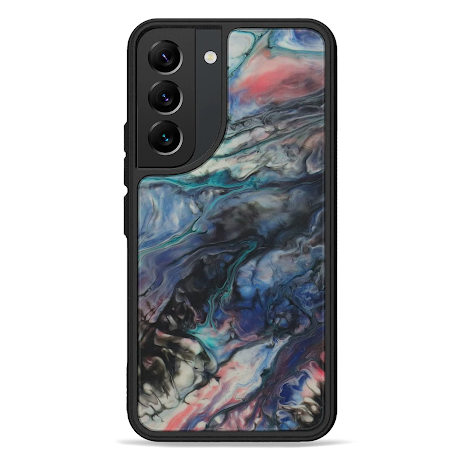
Price: $52
Made In: Indiana, US
Overall score: 3.5/5
Performance: 3.5/5
People: 4/5
Planet: 3/5
Phone Sizes: iPhone (SE-6), Samsung Galaxy (S9-S22)
Pros & Cons
👍 Manufactured in the US
👍 Wood sourced in the US
👍 Supports women’s living wage
👎 Includes plastic
👎 Unclear how to recycle
👎 Only available for iPhone and Samsung Galaxy
If you enjoy nature, responsible sourcing, and supporting the living wages of women, Carved has you covered. These unique cases are made from wood burls—the gnarly growths on roots and trunks that almost look like warts. Ethically sourced and purchased directly from those who harvest them, Carved wood burls come from Northern California, Northern Oregon, and even locally in Indiana. Like the wood grain in your coffee table, every cut has a distinct pattern, creating truly one-of-a-kind cases.
Prefer your phone’s side buttons to be clicky and tactile? These are made with hard plastic buttons. The cases are also made with thermoplastic polyurethane (TPU), which is a blend of plastic and silicone. This rubber-like substance is said to give some extra shock absorption, but we haven’t had a chance to test its protection from falls yet.
When you purchase a Carved case, you do more than support a local business; you support women in Thailand. Every case is shipped in a bag made by Braverly, a company that employs women with safe, well-paying jobs.
You may not be able to toss this case in your compost bin, but TPU biodegrades in 3-5 years. It’s also recyclable, but we’re not sure where or how to recycle your whole phone case at the end of its life. From our research, it doesn’t look like Carved has a return/recycle program yet.
Where to Buy
→ $52﹘carved.com
Why Buy a Sustainable Phone Case
When the average user replaces their phone every 21 months, it’s fair to say that phone cases are adding to our overflowing landfills. More than one billion plastic phone cases are sold every year and most aren’t biodegradable. But don’t fret! That’s why we’ve put together this list of sustainable options.
Where blended plastic takes 500 years to decompose, compostable phone cases take around 6 months at home (vs. about 12 weeks in an industrial facility). It’s not too late to opt for more environmentally-friendly phone case options.
Whether you want to toss your phone into a compost pile at the end of its life or return it for proper disposal, we hope you’ll find a case that fits your values and needs.
What To Do with Old Phone Cases
Before you throw your old phone case in the trash, here are some ideas to close the plastic phone case loop:
- Donate your old case to Goodwill or Plato’s Closet.
- Reuse as a handy tray surface or cord wrap.
- Recycle through Terracycle, Pela 360, or CASETiFY
What Makes an Eco-Friendly or Sustainable Phone Case?
From supply chains to raw materials, a number of factors contribute to every brand or product’s level of sustainability. We evaluated each across three variables: performance, people, and planet.
Performance (Product)
Designs
Since most of us have our phones on us all day, it’s important to find a look you love. We chose a variety of phone brands to make sure there’s a design for everyone, whether you prefer simplistic and clean or fun and artistic.
For Cory, he prefers a basic case, which you can find with Pela, 15:21, Wave, and more.
If you need something bright and eye-catching—so you don’t misplace your phone 14 times a day 🙈. Casetify’s bamboo cases have everything from fun florals to a cat eating ramen.
A Good Company has done various collaborations with independent artists, which produces unique designs and of course, helps support their work.
Durability
Based on personal experience and research, we evaluated each phone based on how long the product lasts and as well, whether or not the case was successful at doing its job (protecting the phone).
In our first-hand experience with the cases, we paid special attention to any bumps, scuffs, or cracks picked up from day-to-day phone use, and likewise scoured reviews from other customers to see if they had any troubles.
Standing behind their product’s durability, most brands offer a warranty of some sort, ranging from 6 months to 4 years, with 15:21 offering the longest warranty. Overall, our top picks for performance are Pela and A Good Company.
Phone Sizes
A sustainable phone won’t work for you if it doesn’t fit your phone 😅. When we assessed these products, we checked for a diversity of phones and sizes to make sure they’ll work for iPhones, Samsungs, and more. Pela and CASETiFY offer the most phone sizes and brands, while Go Nimble only covers iPhones.
People (Ethics)
Transparency
Measuring transparency is a matter of how hard/easy it is to find information on sourcing, production, and labor practices. Those higher on the sustainability spectrum lay out the production process and/or clarify the supply chain.
Pela is pretty open about its production process. Right on the About page, they include a video that walks through how they produce their compostable phone cases.
A Good Company shares a sneak peek of its supply chain, laying out four stops that the product goes through:
- Farm
- Factory 1
- Factory 2
- Print shop
Labor
It was challenging to uncover information on phone case laborers. Some companies share a few basics, some provide very little info.
A Good Company is a good starting point. It includes an interactive map to show factory locations and a table showing the number of workers and hours of operation.
For each factory, they also include areas for improvement, including “meet labor representatives next time we go.”
Most of the other brands on our list shared very limited information on the labor conditions in their supply chains. Of course, we jump to assume the cases are made in unethical means, but we do approach our reporting of those specific cases with a high degree of skepticism.
Contribution
To assess a company’s contribution, we look for charitable giving programs and whether a percentage of sales goes towards supporting the community.
Most of the brands contribute in some way. Throughout the year, Casetify puts collections together to contribute to causes ranging from mental health to LGBTQ empowerment.
For Mental Health Awareness month, they donated $5 from every sale to Sad Girls Club, a community that works to diminish mental health stigma and uplift women of color.
We put together an overview in case you want to choose a case based on a specific cause:
| CASE | ORGANIZATION | CAUSE |
| Pela | 1% of the Planet | 🌏Environmental solutions |
| A Good Company | A Good Foundation | 🌍 Sustainability projects across the world |
| 15:21 | N/A | 🌳 Survival of cork forests |
| Casetify | Varies | 🏳️🌈🧠🤝Read more about #CASETiFYCares |
| Go Nimble | Sheldrick Wildlife Trust | 🐘 Elephant rescue organization |
| Wave | Plastic Bank | 🌊 Fight against plastic pollution in the ocean |
| Carved | Braverly | 👭 Empower women in Thailand with safe, fair-paying jobs |
Planet (Sustainability)
Materials
Good news! Five of the brands we reviewed offer plastic-free options. From our research, materially speaking, the Pela Case and A Good Mobile Case stand out as offering the most sustainable options.
Go Nimble cases may not be plastic-free, but they are made with recycled plastic. Carved uses plastic but also leans on many other ethically sourced materials, including rubber and wood burls.
Shipping and Packaging
For sustainable packaging, we looked at three characteristics:
- Recyclable
- Compostable
- Carbon offsets
From our research, Pela appears to check all three boxes.
Usually, we assess transportation along the supply chain, but we found limited information on phone case shipping.
End of Life/Circularity
We looked at three areas to determine a product’s end-of-life options:
- At-home composting
- Industrial composting
- Return + recycle/compost program
Pela and A Good Company are tied for first, with CASETiFY following shortly after.
Buy a Sustainable Phone Case, Buy Ensemble
While sustainability exists on a spectrum, some brands are further along in their journey. If you want to protect your phone with a durable case—and keep its end of life from the landfill—we hope this review gives you a good starting point.
Note: we inform brands that product exchanges can not/do not influence our reviews.
P.S. Did we miss anything? Send us a message or leave a comment below.